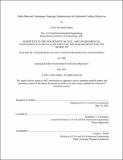Multi-Material Continuum Topology Optimization for Embodied Carbon Objectives
Author(s)
Holley, Claire Elizabeth
DownloadThesis PDF (1.222Mb)
Advisor
Carstensen, Josephine V.
Terms of use
Metadata
Show full item recordAbstract
Recent years have seen an increase in research and practical interest that seek to lower the carbon footprint of infrastructure and building design. Typically, carbon emissions from the built environment are divided into two categories: operational emissions and embodied carbon. Over the past decades, most work has focused on lowering the operational carbon, so now attention has turned to lowering the embodied carbon, which constitutes a significant proportion of the carbon emissions over the lifecycle of a building. Within structural design of buildings and infrastructure, topology optimization is an emerging technology, often seeking to make structures more materially efficient. It therefore offers a means to reduce the structural weight, and as such, minimize the global warming potential (GWP). This research provides an exploration of bi-material optimization problems that minimize GWP as well as compliance for a series of representative models. Two materials are considered; one with a stiff, high embodied carbon coefficient (ECC) material, such as steel, and a less stiff, lower ECC material, such as timber or concrete.
This work presents multi-material topology optimization frameworks that lower the embodied carbon for continuum design. For both cases of compliance and GWP minimization, an additional set of design variables are used to control the material selection. The framework uses a density-based approach to topology optimization and existing multi-material formulations. For the design, the Solid Isotropic Material with Penalization (SIMP) method is used to penalize intermediate material choices and fmincon is taken as the gradient based optimizer. The frameworks are demonstrated on several benchmark examples and compared between the two optimization problems. In both cases, the stiffer material was generally placed near supports and where loading is applied. The results show not only optimization through material selection, but topology optimization in shape and size.
Date issued
2021-06Department
Massachusetts Institute of Technology. Department of Civil and Environmental EngineeringPublisher
Massachusetts Institute of Technology